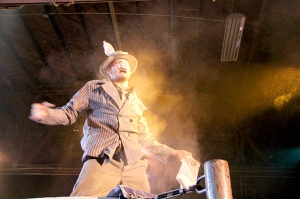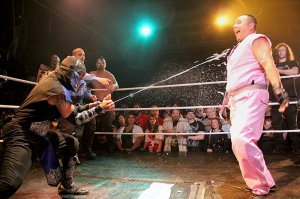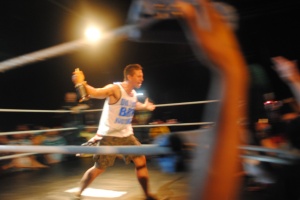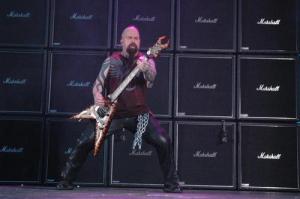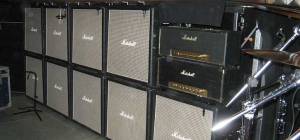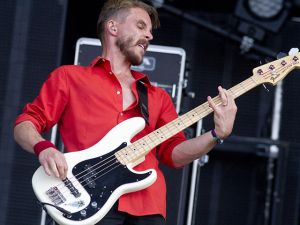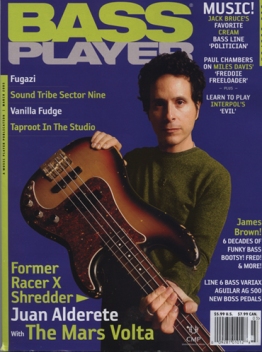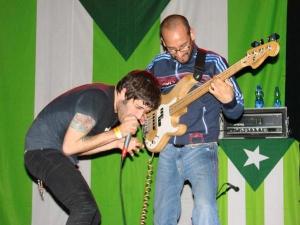Audience members pass blunts and pipes in the dark, taking sips on cold beers from the bar. The atmosphere is dark, loud and smoky; it feels like a punk rock show, with only the ring to remind you that this is a wrestling event.
Hundreds of fans shuffle in and immediately crowd the ring in the standing-room only venue, cheering and pounding their fists, chanting “This is real! This is real! F–k the fans!” This is the scene at “Boys in the Hoodslam, the 37th Chamber,” the latest in an independent wrestling event held first on Fridays at the Oakland Metro Operahouse.
Hoodslam is a unique independently owned and operated wrestling league featuring crazy costumes, thrilling action and an atmosphere like no other entertainment event. The event has been gaining momentum, press and recently some unwanted attention from the Sacramento Police.
On June 22, a scheduled Hoodslam event in Sacramento was shut down before doors opened by Sacramento P.D., who claimed the event coordinators did not have proper permits for a “live for-profit entertainment event.” According to fans, the Sacramento P.D. sent approximately six cop cars to stop the event.
“They shut us down an hour before doors opened,” explained event commentator, Hoodslam wrestler Broseph Joe Brody and former WWE Tough Enough contestant A.J. Kirsch. “It’s kind of silly, if you think about it; if you look up the public record for that night, there were burglaries and assaults reported all over Sacramento but, they sent that many cars for Hoodslam?”
With a full bar, live band and matches featuring characters like Dan and Ken from Street Fighter, the feel in the room is electrifying. The wrestling itself is high flying, dynamic and extremely physical, often spilling out of the ring and into the crowd, sending the startled audience into a frenzy. Wrestlers are regularly thrown and slammed from the top of the ropes in remarkably technical displays of athleticism.
Brainchild of a group of friends and pro wrestlers and event founder Sam Khandaghabadi, the event has been steadily gaining popularity since 2010.
“The first show was put on by about 12 people, in a warehouse rented by the guys that would become the Hoodslam band. They were small shows for a few dozen people, and it was free. It was just something for our friends, something for us” said Hoodslam wrestler and co-founder Johnny “Drinko” Butabi.“Most wrestling is so sterile, we just wanted to do something different and we wanted to be able to smoke and drink and do it our way,” said Butabi, who declined to disclose his actual name.
“I remember Sam [Khandaghabadi], like literally while passing a blunt, mentioning this idea for a show that was wrestling but totally different,” explained event commentator Kevin Gill with a grin. “I knew I wanted to be involved immediately, and here we are three years later.”
The production has grown to a crew of dozens to facilitate the smooth operation each first Friday.
“I think it’s about word of mouth, you trust your friends saying ‘dude you’ve got to check this out!’ that does more than any flier or post on a webpage” said Kirsch, referring to the event’s increasing popularity. Hoodslam productions typically average seven hundred spectators.
Before the wrestling even begins, commentator A.J. Kirsch as Broseph Joe Brody circles the ring with a bottle, pouring huge shots of whiskey into fan’s mouths.
“I’ll go around the ring with a bottle of liquor until it’s completely empty; we’re always thinking, how do I get them to say ‘and then this happened, and this happened!’” exclaimed Kirsch.
What truly makes Hoodslam different is the characters; each has a back story and elaborate costume design. Some characters, like Sub-Zero and Scorpion from Mortal Kombat, or infamous gangster Jessie James are lifted straight from pop culture, while others are original creations.
“The characters, Drugz Bunny, Otis the Gimp from Pulp Fiction–when these things work, you have something people can get behind,” explained Kirsch. “We want people to suspend their disbelief and get lost in it.”
According to Kirsch, the event’s costumes and sets are homemade by the Hoodslam staff and performers in a labor of love and finding inexpensive ways to add nuances that make the experience feel real.
When people say ‘This is real,’ it’s kind of funny, because it’s wrestling, so of course it’s not, everyone knows it’s not,” laughs Kirsch. “We’ve had ridiculous moments, some of them you wouldn’t believe unless you saw it, but there’s such a special aura. So much dedication and connection around it that more than anything, that is what’s real.”
Hoodslam will return to the Oakland Metro Operahouse on Friday August 2 for “Battle Royal of Supremacy: Daze of Future Past.” Admittance at the door is $15 and all events are 21+.
